Managing Across Cultures: Importance of Training Managers for Competency
VerifiedAdded on 2023/06/03
|12
|2477
|130
AI Summary
This assignment focuses on the need for the managers to attain training under different working and management styles to manage a diverse cultural workforce. The report explores the various aspects of a cross-cultural workforce that includes the influence on the working styles due to the div...
Read More
Contribute Materials
Your contribution can guide someone’s learning journey. Share your
documents today.
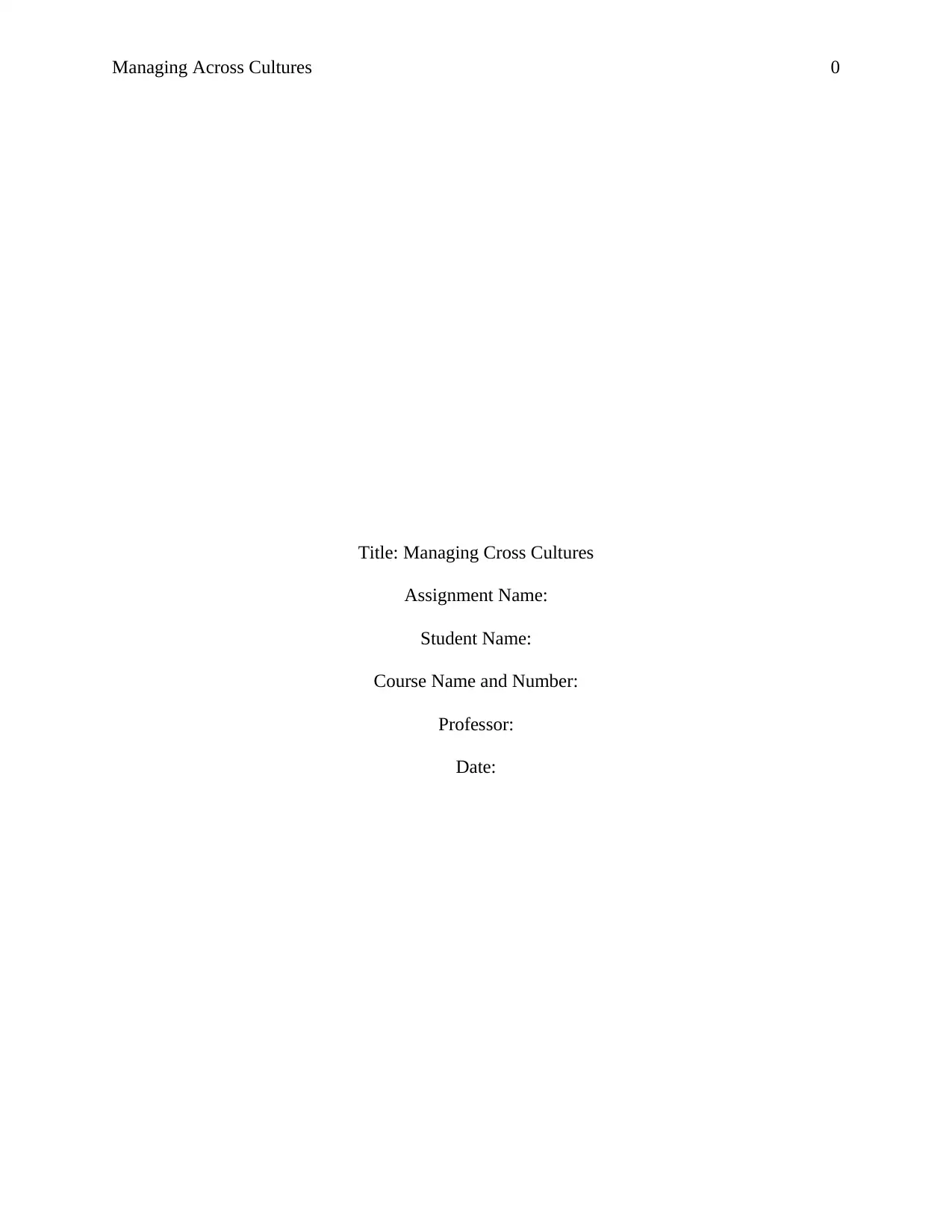
Managing Across Cultures 0
Title: Managing Cross Cultures
Assignment Name:
Student Name:
Course Name and Number:
Professor:
Date:
Title: Managing Cross Cultures
Assignment Name:
Student Name:
Course Name and Number:
Professor:
Date:
Secure Best Marks with AI Grader
Need help grading? Try our AI Grader for instant feedback on your assignments.
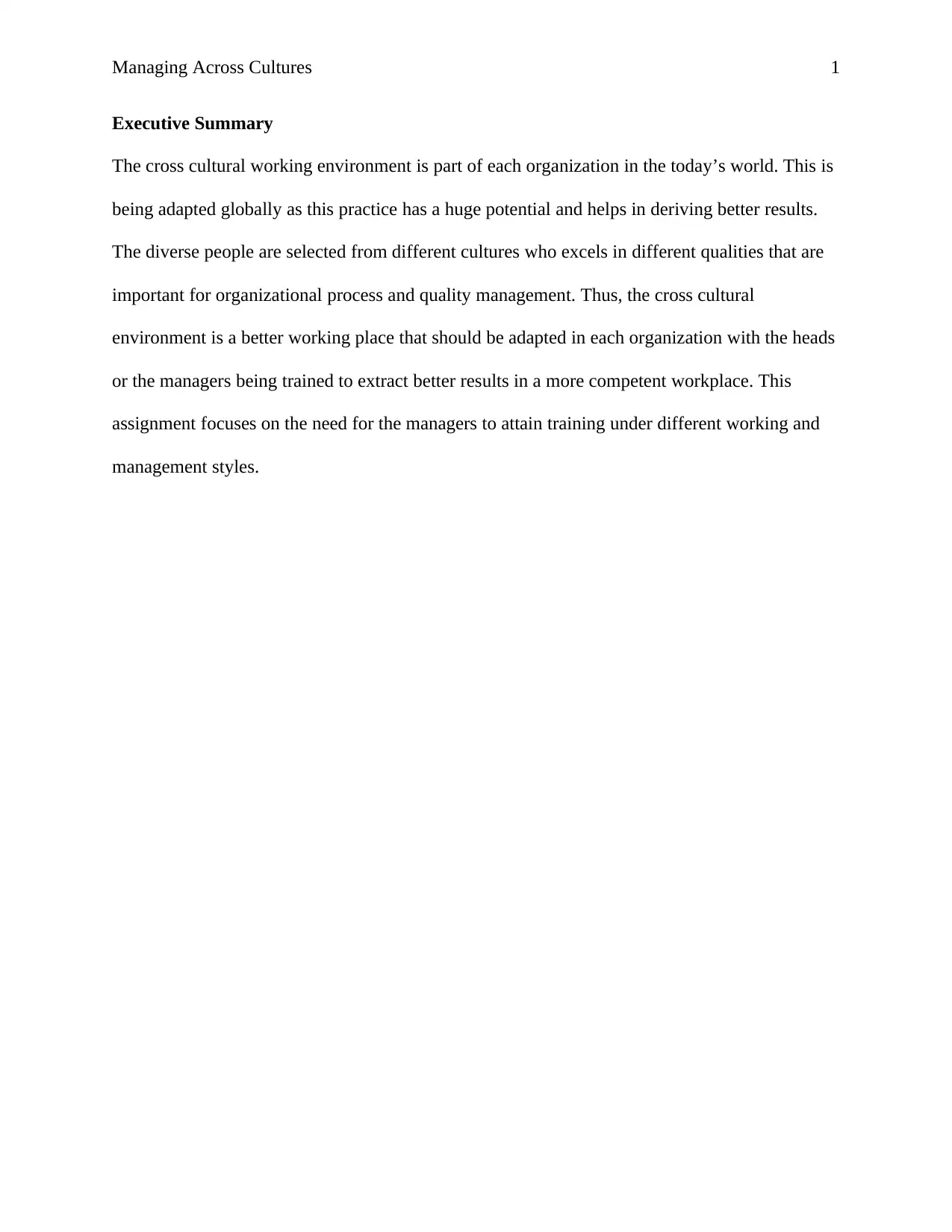
Managing Across Cultures 1
Executive Summary
The cross cultural working environment is part of each organization in the today’s world. This is
being adapted globally as this practice has a huge potential and helps in deriving better results.
The diverse people are selected from different cultures who excels in different qualities that are
important for organizational process and quality management. Thus, the cross cultural
environment is a better working place that should be adapted in each organization with the heads
or the managers being trained to extract better results in a more competent workplace. This
assignment focuses on the need for the managers to attain training under different working and
management styles.
Executive Summary
The cross cultural working environment is part of each organization in the today’s world. This is
being adapted globally as this practice has a huge potential and helps in deriving better results.
The diverse people are selected from different cultures who excels in different qualities that are
important for organizational process and quality management. Thus, the cross cultural
environment is a better working place that should be adapted in each organization with the heads
or the managers being trained to extract better results in a more competent workplace. This
assignment focuses on the need for the managers to attain training under different working and
management styles.
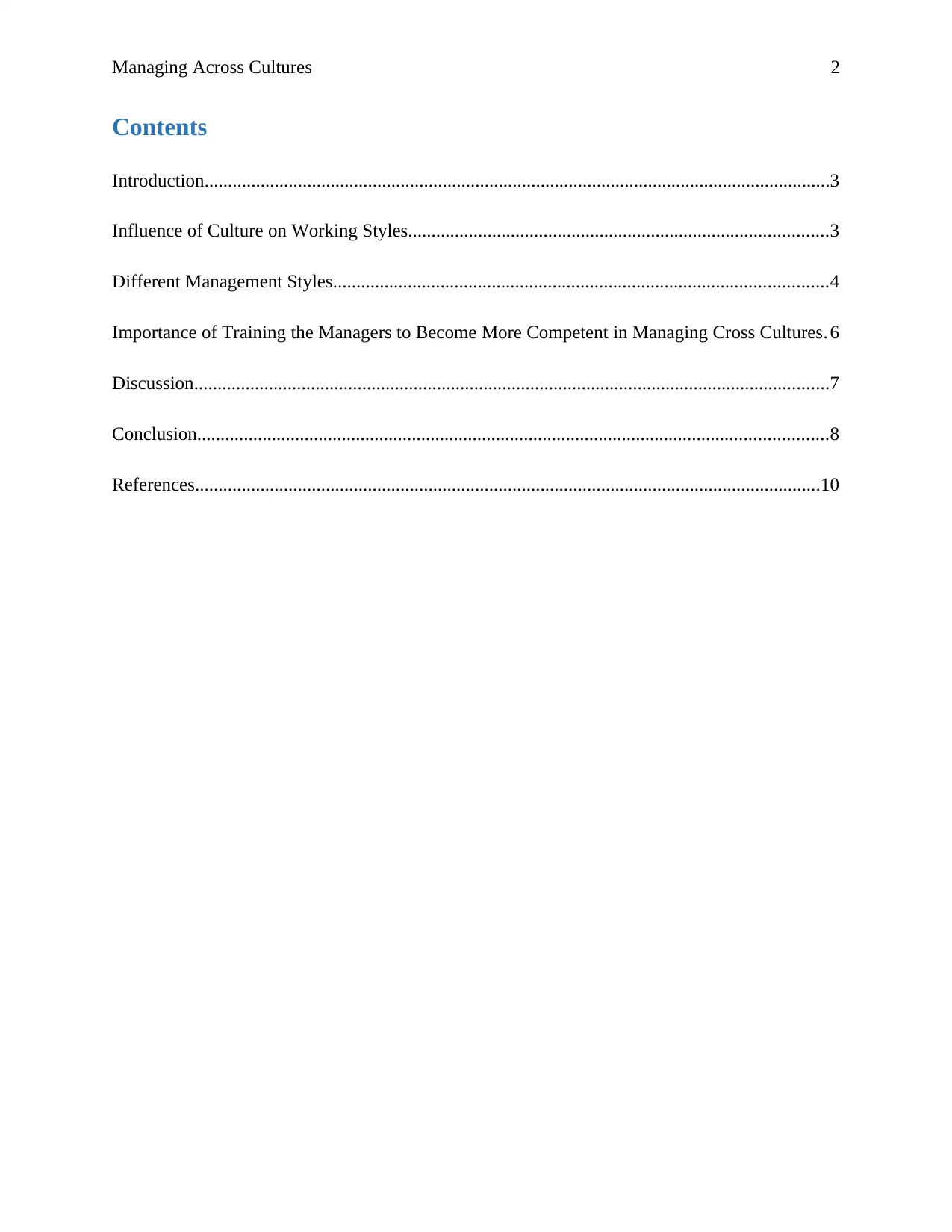
Managing Across Cultures 2
Contents
Introduction......................................................................................................................................3
Influence of Culture on Working Styles..........................................................................................3
Different Management Styles..........................................................................................................4
Importance of Training the Managers to Become More Competent in Managing Cross Cultures. 6
Discussion........................................................................................................................................7
Conclusion.......................................................................................................................................8
References......................................................................................................................................10
Contents
Introduction......................................................................................................................................3
Influence of Culture on Working Styles..........................................................................................3
Different Management Styles..........................................................................................................4
Importance of Training the Managers to Become More Competent in Managing Cross Cultures. 6
Discussion........................................................................................................................................7
Conclusion.......................................................................................................................................8
References......................................................................................................................................10
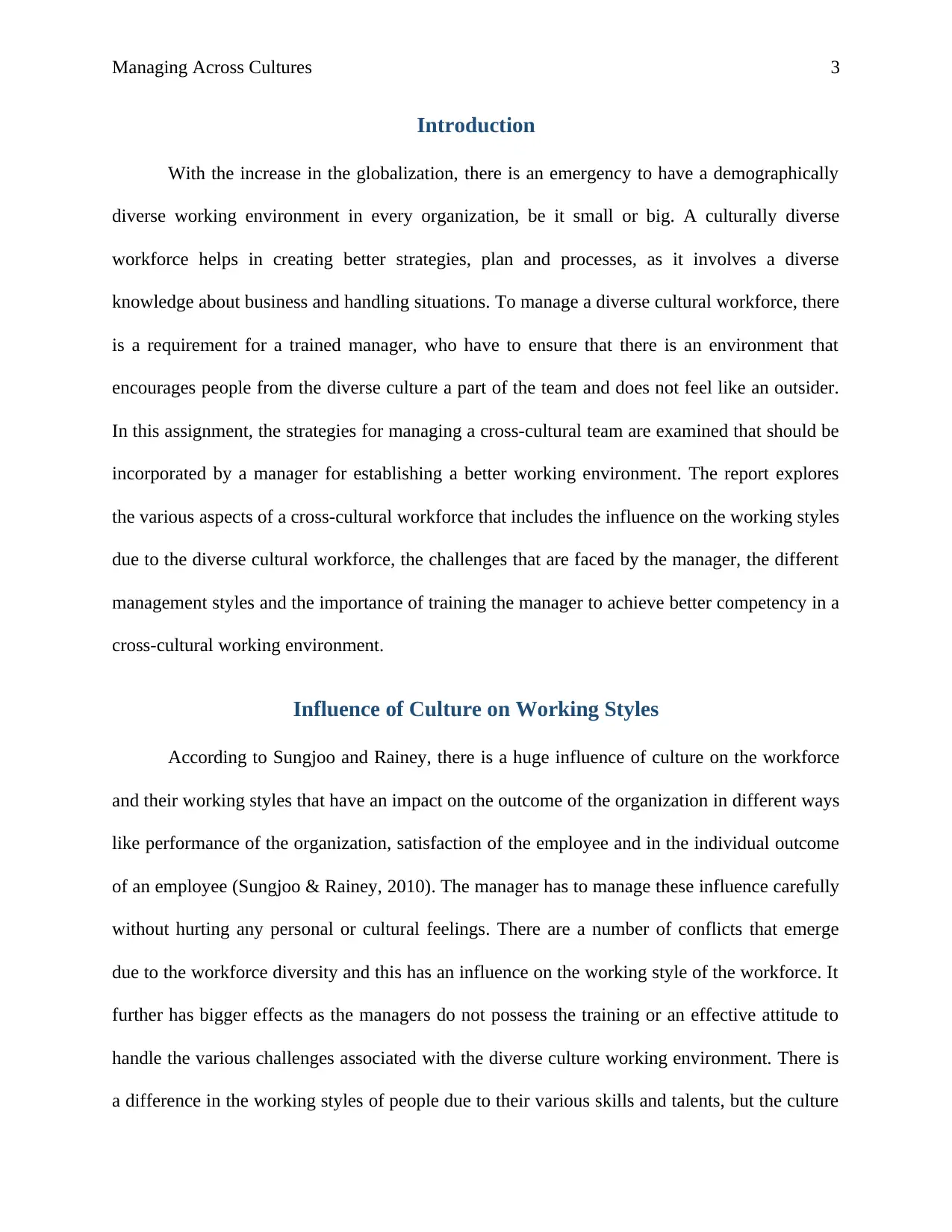
Managing Across Cultures 3
Introduction
With the increase in the globalization, there is an emergency to have a demographically
diverse working environment in every organization, be it small or big. A culturally diverse
workforce helps in creating better strategies, plan and processes, as it involves a diverse
knowledge about business and handling situations. To manage a diverse cultural workforce, there
is a requirement for a trained manager, who have to ensure that there is an environment that
encourages people from the diverse culture a part of the team and does not feel like an outsider.
In this assignment, the strategies for managing a cross-cultural team are examined that should be
incorporated by a manager for establishing a better working environment. The report explores
the various aspects of a cross-cultural workforce that includes the influence on the working styles
due to the diverse cultural workforce, the challenges that are faced by the manager, the different
management styles and the importance of training the manager to achieve better competency in a
cross-cultural working environment.
Influence of Culture on Working Styles
According to Sungjoo and Rainey, there is a huge influence of culture on the workforce
and their working styles that have an impact on the outcome of the organization in different ways
like performance of the organization, satisfaction of the employee and in the individual outcome
of an employee (Sungjoo & Rainey, 2010). The manager has to manage these influence carefully
without hurting any personal or cultural feelings. There are a number of conflicts that emerge
due to the workforce diversity and this has an influence on the working style of the workforce. It
further has bigger effects as the managers do not possess the training or an effective attitude to
handle the various challenges associated with the diverse culture working environment. There is
a difference in the working styles of people due to their various skills and talents, but the culture
Introduction
With the increase in the globalization, there is an emergency to have a demographically
diverse working environment in every organization, be it small or big. A culturally diverse
workforce helps in creating better strategies, plan and processes, as it involves a diverse
knowledge about business and handling situations. To manage a diverse cultural workforce, there
is a requirement for a trained manager, who have to ensure that there is an environment that
encourages people from the diverse culture a part of the team and does not feel like an outsider.
In this assignment, the strategies for managing a cross-cultural team are examined that should be
incorporated by a manager for establishing a better working environment. The report explores
the various aspects of a cross-cultural workforce that includes the influence on the working styles
due to the diverse cultural workforce, the challenges that are faced by the manager, the different
management styles and the importance of training the manager to achieve better competency in a
cross-cultural working environment.
Influence of Culture on Working Styles
According to Sungjoo and Rainey, there is a huge influence of culture on the workforce
and their working styles that have an impact on the outcome of the organization in different ways
like performance of the organization, satisfaction of the employee and in the individual outcome
of an employee (Sungjoo & Rainey, 2010). The manager has to manage these influence carefully
without hurting any personal or cultural feelings. There are a number of conflicts that emerge
due to the workforce diversity and this has an influence on the working style of the workforce. It
further has bigger effects as the managers do not possess the training or an effective attitude to
handle the various challenges associated with the diverse culture working environment. There is
a difference in the working styles of people due to their various skills and talents, but the culture
Secure Best Marks with AI Grader
Need help grading? Try our AI Grader for instant feedback on your assignments.
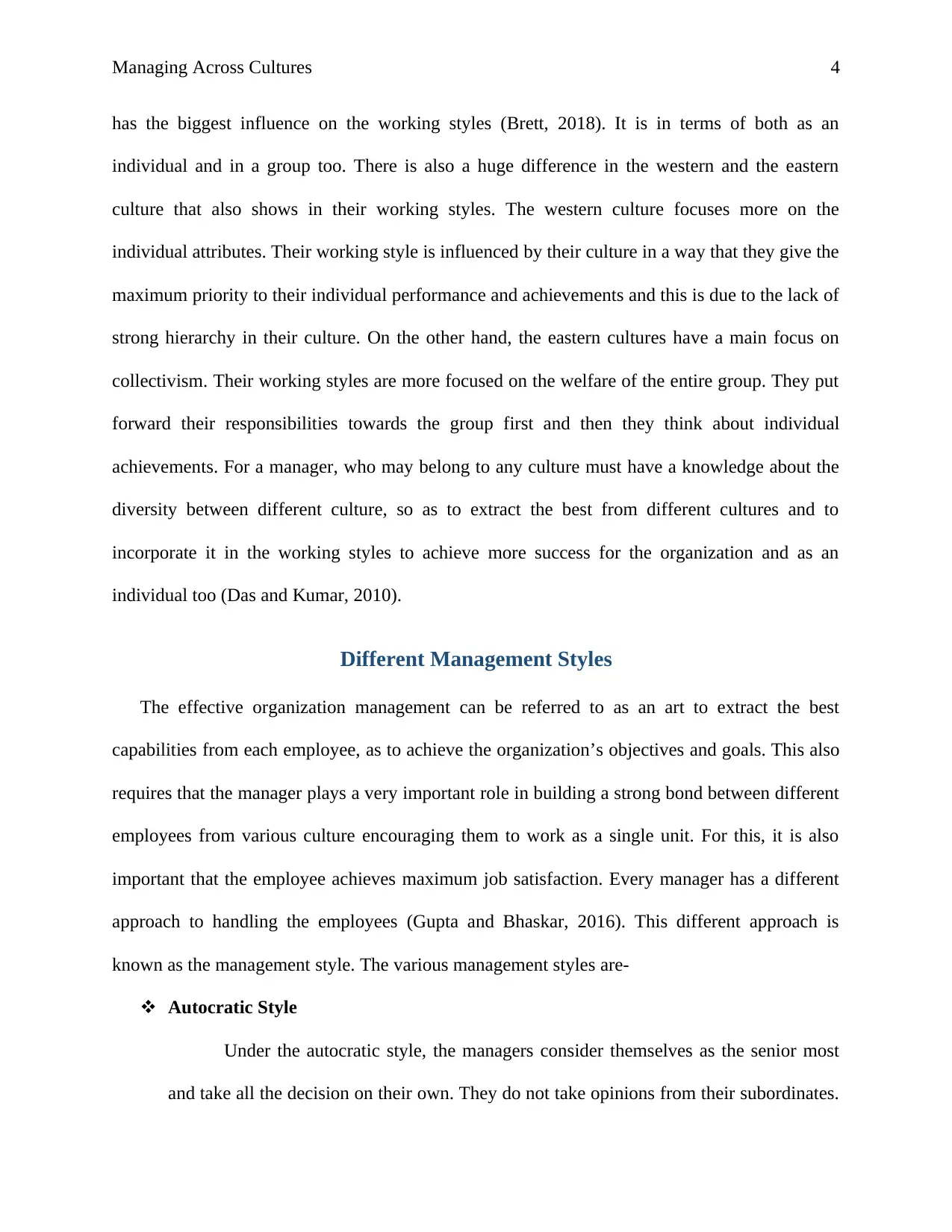
Managing Across Cultures 4
has the biggest influence on the working styles (Brett, 2018). It is in terms of both as an
individual and in a group too. There is also a huge difference in the western and the eastern
culture that also shows in their working styles. The western culture focuses more on the
individual attributes. Their working style is influenced by their culture in a way that they give the
maximum priority to their individual performance and achievements and this is due to the lack of
strong hierarchy in their culture. On the other hand, the eastern cultures have a main focus on
collectivism. Their working styles are more focused on the welfare of the entire group. They put
forward their responsibilities towards the group first and then they think about individual
achievements. For a manager, who may belong to any culture must have a knowledge about the
diversity between different culture, so as to extract the best from different cultures and to
incorporate it in the working styles to achieve more success for the organization and as an
individual too (Das and Kumar, 2010).
Different Management Styles
The effective organization management can be referred to as an art to extract the best
capabilities from each employee, as to achieve the organization’s objectives and goals. This also
requires that the manager plays a very important role in building a strong bond between different
employees from various culture encouraging them to work as a single unit. For this, it is also
important that the employee achieves maximum job satisfaction. Every manager has a different
approach to handling the employees (Gupta and Bhaskar, 2016). This different approach is
known as the management style. The various management styles are-
Autocratic Style
Under the autocratic style, the managers consider themselves as the senior most
and take all the decision on their own. They do not take opinions from their subordinates.
has the biggest influence on the working styles (Brett, 2018). It is in terms of both as an
individual and in a group too. There is also a huge difference in the western and the eastern
culture that also shows in their working styles. The western culture focuses more on the
individual attributes. Their working style is influenced by their culture in a way that they give the
maximum priority to their individual performance and achievements and this is due to the lack of
strong hierarchy in their culture. On the other hand, the eastern cultures have a main focus on
collectivism. Their working styles are more focused on the welfare of the entire group. They put
forward their responsibilities towards the group first and then they think about individual
achievements. For a manager, who may belong to any culture must have a knowledge about the
diversity between different culture, so as to extract the best from different cultures and to
incorporate it in the working styles to achieve more success for the organization and as an
individual too (Das and Kumar, 2010).
Different Management Styles
The effective organization management can be referred to as an art to extract the best
capabilities from each employee, as to achieve the organization’s objectives and goals. This also
requires that the manager plays a very important role in building a strong bond between different
employees from various culture encouraging them to work as a single unit. For this, it is also
important that the employee achieves maximum job satisfaction. Every manager has a different
approach to handling the employees (Gupta and Bhaskar, 2016). This different approach is
known as the management style. The various management styles are-
Autocratic Style
Under the autocratic style, the managers consider themselves as the senior most
and take all the decision on their own. They do not take opinions from their subordinates.
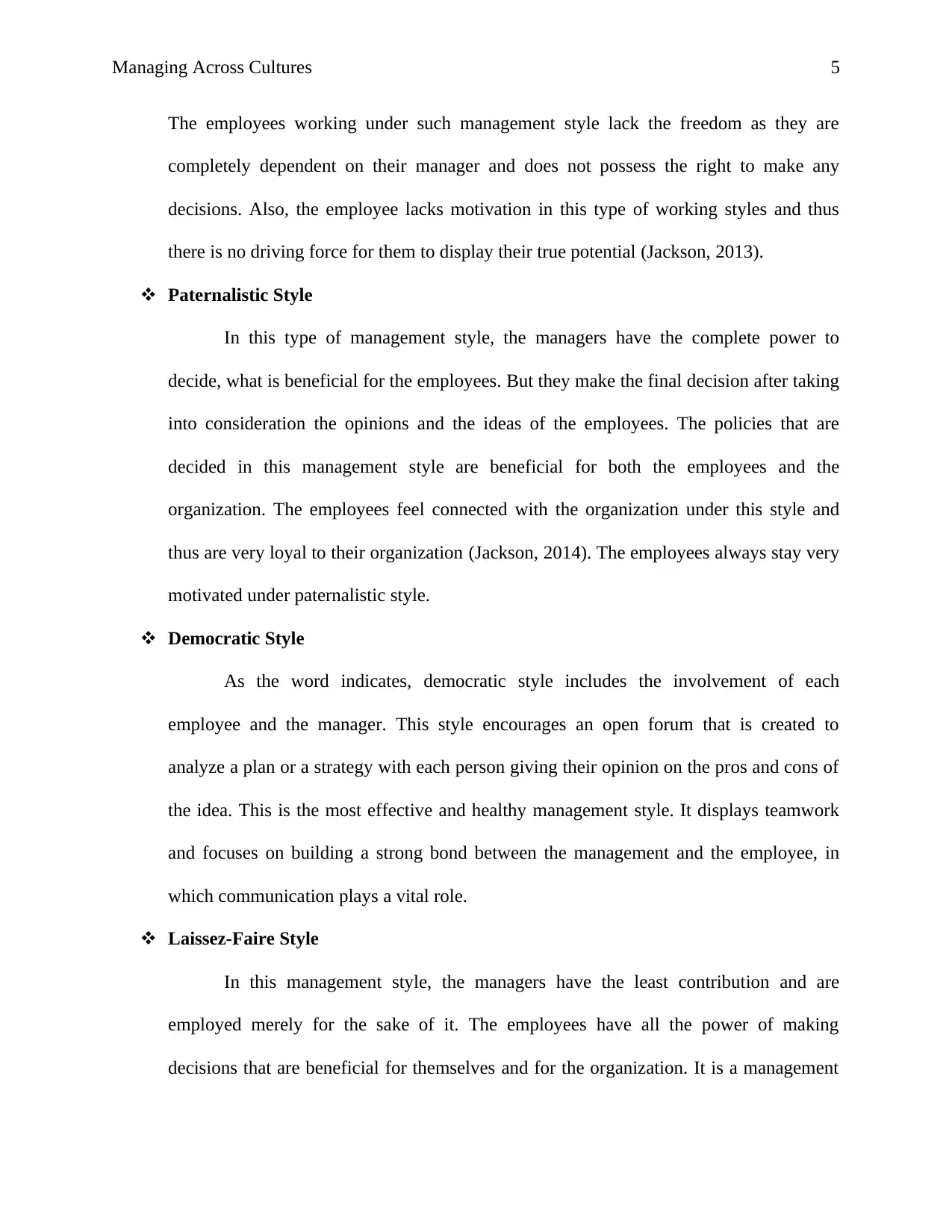
Managing Across Cultures 5
The employees working under such management style lack the freedom as they are
completely dependent on their manager and does not possess the right to make any
decisions. Also, the employee lacks motivation in this type of working styles and thus
there is no driving force for them to display their true potential (Jackson, 2013).
Paternalistic Style
In this type of management style, the managers have the complete power to
decide, what is beneficial for the employees. But they make the final decision after taking
into consideration the opinions and the ideas of the employees. The policies that are
decided in this management style are beneficial for both the employees and the
organization. The employees feel connected with the organization under this style and
thus are very loyal to their organization (Jackson, 2014). The employees always stay very
motivated under paternalistic style.
Democratic Style
As the word indicates, democratic style includes the involvement of each
employee and the manager. This style encourages an open forum that is created to
analyze a plan or a strategy with each person giving their opinion on the pros and cons of
the idea. This is the most effective and healthy management style. It displays teamwork
and focuses on building a strong bond between the management and the employee, in
which communication plays a vital role.
Laissez-Faire Style
In this management style, the managers have the least contribution and are
employed merely for the sake of it. The employees have all the power of making
decisions that are beneficial for themselves and for the organization. It is a management
The employees working under such management style lack the freedom as they are
completely dependent on their manager and does not possess the right to make any
decisions. Also, the employee lacks motivation in this type of working styles and thus
there is no driving force for them to display their true potential (Jackson, 2013).
Paternalistic Style
In this type of management style, the managers have the complete power to
decide, what is beneficial for the employees. But they make the final decision after taking
into consideration the opinions and the ideas of the employees. The policies that are
decided in this management style are beneficial for both the employees and the
organization. The employees feel connected with the organization under this style and
thus are very loyal to their organization (Jackson, 2014). The employees always stay very
motivated under paternalistic style.
Democratic Style
As the word indicates, democratic style includes the involvement of each
employee and the manager. This style encourages an open forum that is created to
analyze a plan or a strategy with each person giving their opinion on the pros and cons of
the idea. This is the most effective and healthy management style. It displays teamwork
and focuses on building a strong bond between the management and the employee, in
which communication plays a vital role.
Laissez-Faire Style
In this management style, the managers have the least contribution and are
employed merely for the sake of it. The employees have all the power of making
decisions that are beneficial for themselves and for the organization. It is a management
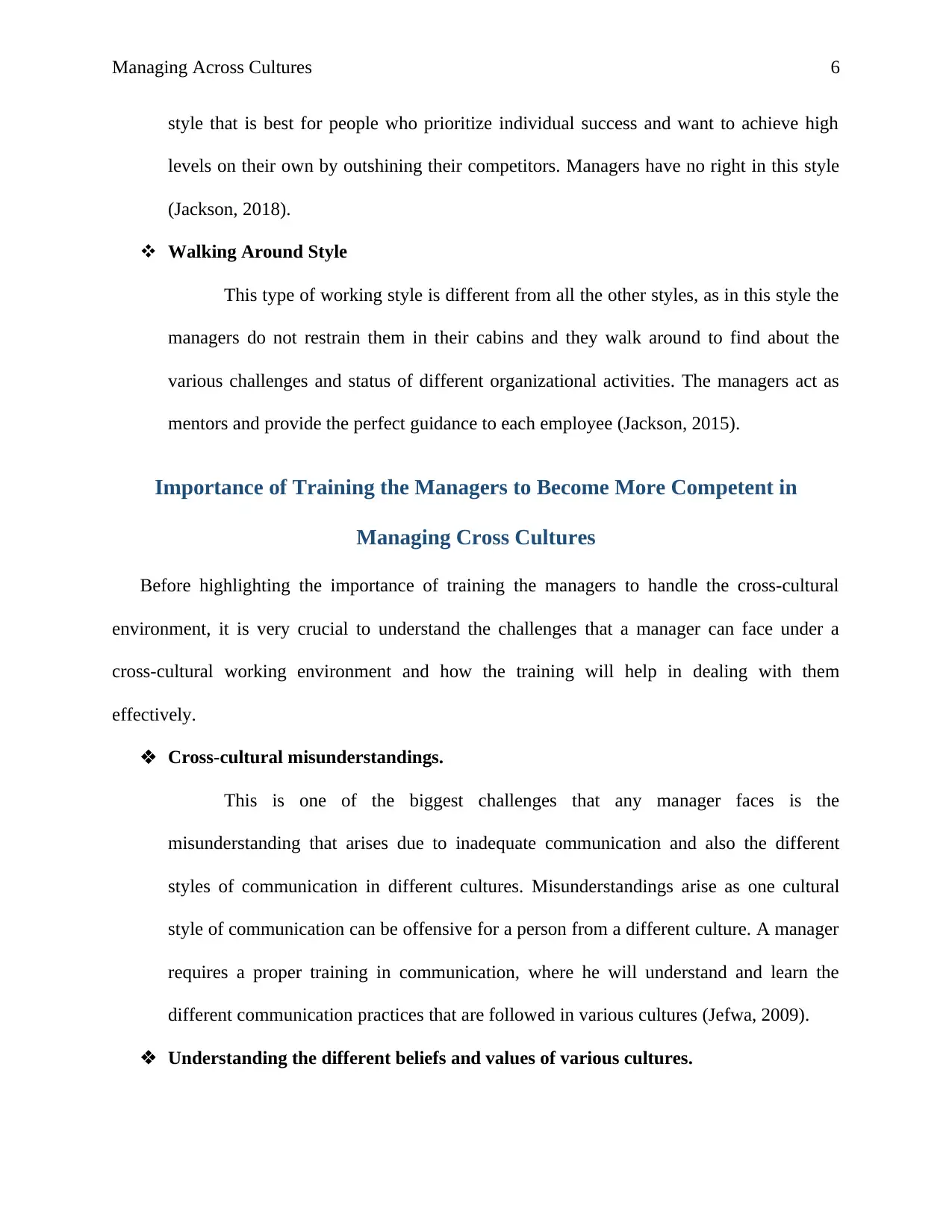
Managing Across Cultures 6
style that is best for people who prioritize individual success and want to achieve high
levels on their own by outshining their competitors. Managers have no right in this style
(Jackson, 2018).
Walking Around Style
This type of working style is different from all the other styles, as in this style the
managers do not restrain them in their cabins and they walk around to find about the
various challenges and status of different organizational activities. The managers act as
mentors and provide the perfect guidance to each employee (Jackson, 2015).
Importance of Training the Managers to Become More Competent in
Managing Cross Cultures
Before highlighting the importance of training the managers to handle the cross-cultural
environment, it is very crucial to understand the challenges that a manager can face under a
cross-cultural working environment and how the training will help in dealing with them
effectively.
Cross-cultural misunderstandings.
This is one of the biggest challenges that any manager faces is the
misunderstanding that arises due to inadequate communication and also the different
styles of communication in different cultures. Misunderstandings arise as one cultural
style of communication can be offensive for a person from a different culture. A manager
requires a proper training in communication, where he will understand and learn the
different communication practices that are followed in various cultures (Jefwa, 2009).
Understanding the different beliefs and values of various cultures.
style that is best for people who prioritize individual success and want to achieve high
levels on their own by outshining their competitors. Managers have no right in this style
(Jackson, 2018).
Walking Around Style
This type of working style is different from all the other styles, as in this style the
managers do not restrain them in their cabins and they walk around to find about the
various challenges and status of different organizational activities. The managers act as
mentors and provide the perfect guidance to each employee (Jackson, 2015).
Importance of Training the Managers to Become More Competent in
Managing Cross Cultures
Before highlighting the importance of training the managers to handle the cross-cultural
environment, it is very crucial to understand the challenges that a manager can face under a
cross-cultural working environment and how the training will help in dealing with them
effectively.
Cross-cultural misunderstandings.
This is one of the biggest challenges that any manager faces is the
misunderstanding that arises due to inadequate communication and also the different
styles of communication in different cultures. Misunderstandings arise as one cultural
style of communication can be offensive for a person from a different culture. A manager
requires a proper training in communication, where he will understand and learn the
different communication practices that are followed in various cultures (Jefwa, 2009).
Understanding the different beliefs and values of various cultures.
Paraphrase This Document
Need a fresh take? Get an instant paraphrase of this document with our AI Paraphraser
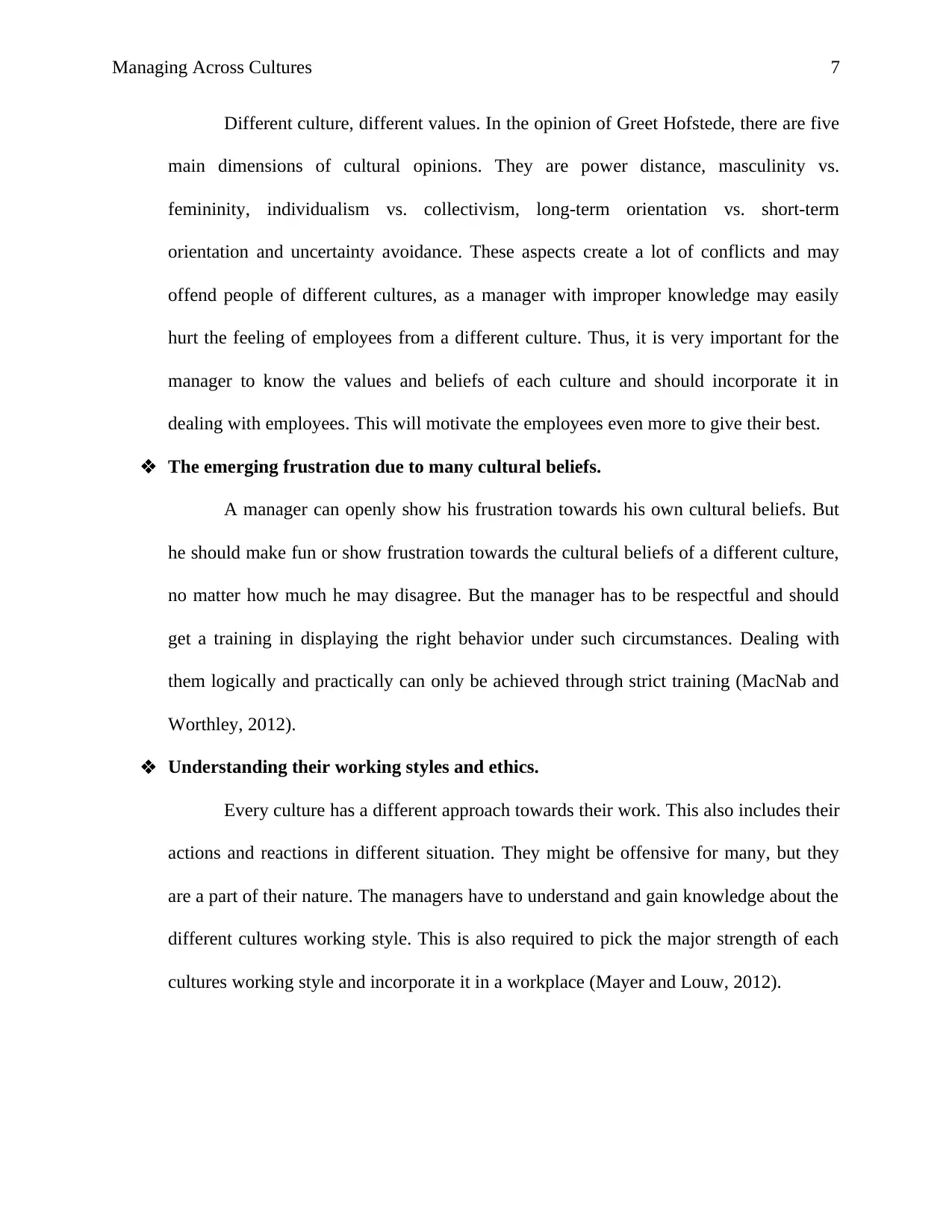
Managing Across Cultures 7
Different culture, different values. In the opinion of Greet Hofstede, there are five
main dimensions of cultural opinions. They are power distance, masculinity vs.
femininity, individualism vs. collectivism, long-term orientation vs. short-term
orientation and uncertainty avoidance. These aspects create a lot of conflicts and may
offend people of different cultures, as a manager with improper knowledge may easily
hurt the feeling of employees from a different culture. Thus, it is very important for the
manager to know the values and beliefs of each culture and should incorporate it in
dealing with employees. This will motivate the employees even more to give their best.
The emerging frustration due to many cultural beliefs.
A manager can openly show his frustration towards his own cultural beliefs. But
he should make fun or show frustration towards the cultural beliefs of a different culture,
no matter how much he may disagree. But the manager has to be respectful and should
get a training in displaying the right behavior under such circumstances. Dealing with
them logically and practically can only be achieved through strict training (MacNab and
Worthley, 2012).
Understanding their working styles and ethics.
Every culture has a different approach towards their work. This also includes their
actions and reactions in different situation. They might be offensive for many, but they
are a part of their nature. The managers have to understand and gain knowledge about the
different cultures working style. This is also required to pick the major strength of each
cultures working style and incorporate it in a workplace (Mayer and Louw, 2012).
Different culture, different values. In the opinion of Greet Hofstede, there are five
main dimensions of cultural opinions. They are power distance, masculinity vs.
femininity, individualism vs. collectivism, long-term orientation vs. short-term
orientation and uncertainty avoidance. These aspects create a lot of conflicts and may
offend people of different cultures, as a manager with improper knowledge may easily
hurt the feeling of employees from a different culture. Thus, it is very important for the
manager to know the values and beliefs of each culture and should incorporate it in
dealing with employees. This will motivate the employees even more to give their best.
The emerging frustration due to many cultural beliefs.
A manager can openly show his frustration towards his own cultural beliefs. But
he should make fun or show frustration towards the cultural beliefs of a different culture,
no matter how much he may disagree. But the manager has to be respectful and should
get a training in displaying the right behavior under such circumstances. Dealing with
them logically and practically can only be achieved through strict training (MacNab and
Worthley, 2012).
Understanding their working styles and ethics.
Every culture has a different approach towards their work. This also includes their
actions and reactions in different situation. They might be offensive for many, but they
are a part of their nature. The managers have to understand and gain knowledge about the
different cultures working style. This is also required to pick the major strength of each
cultures working style and incorporate it in a workplace (Mayer and Louw, 2012).
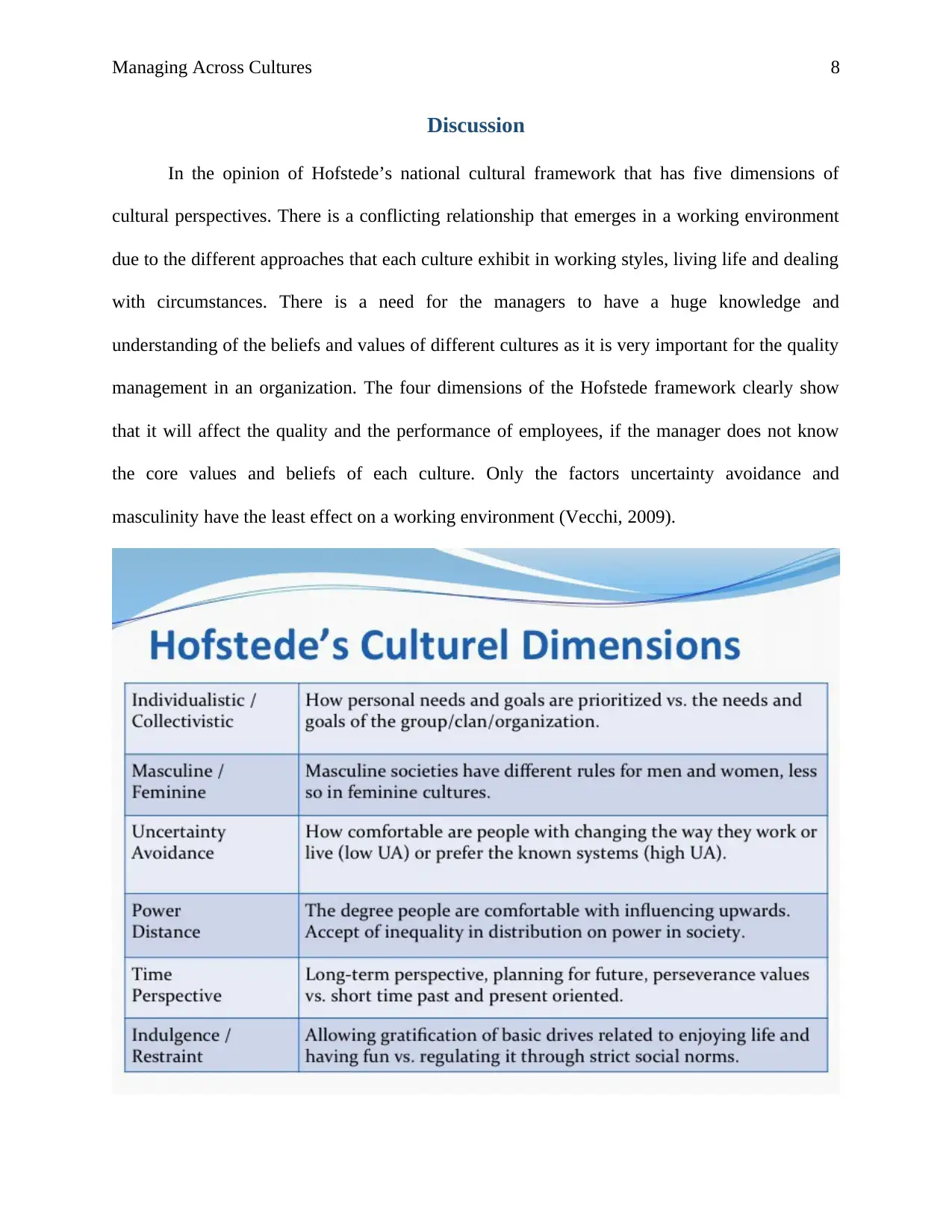
Managing Across Cultures 8
Discussion
In the opinion of Hofstede’s national cultural framework that has five dimensions of
cultural perspectives. There is a conflicting relationship that emerges in a working environment
due to the different approaches that each culture exhibit in working styles, living life and dealing
with circumstances. There is a need for the managers to have a huge knowledge and
understanding of the beliefs and values of different cultures as it is very important for the quality
management in an organization. The four dimensions of the Hofstede framework clearly show
that it will affect the quality and the performance of employees, if the manager does not know
the core values and beliefs of each culture. Only the factors uncertainty avoidance and
masculinity have the least effect on a working environment (Vecchi, 2009).
Discussion
In the opinion of Hofstede’s national cultural framework that has five dimensions of
cultural perspectives. There is a conflicting relationship that emerges in a working environment
due to the different approaches that each culture exhibit in working styles, living life and dealing
with circumstances. There is a need for the managers to have a huge knowledge and
understanding of the beliefs and values of different cultures as it is very important for the quality
management in an organization. The four dimensions of the Hofstede framework clearly show
that it will affect the quality and the performance of employees, if the manager does not know
the core values and beliefs of each culture. Only the factors uncertainty avoidance and
masculinity have the least effect on a working environment (Vecchi, 2009).
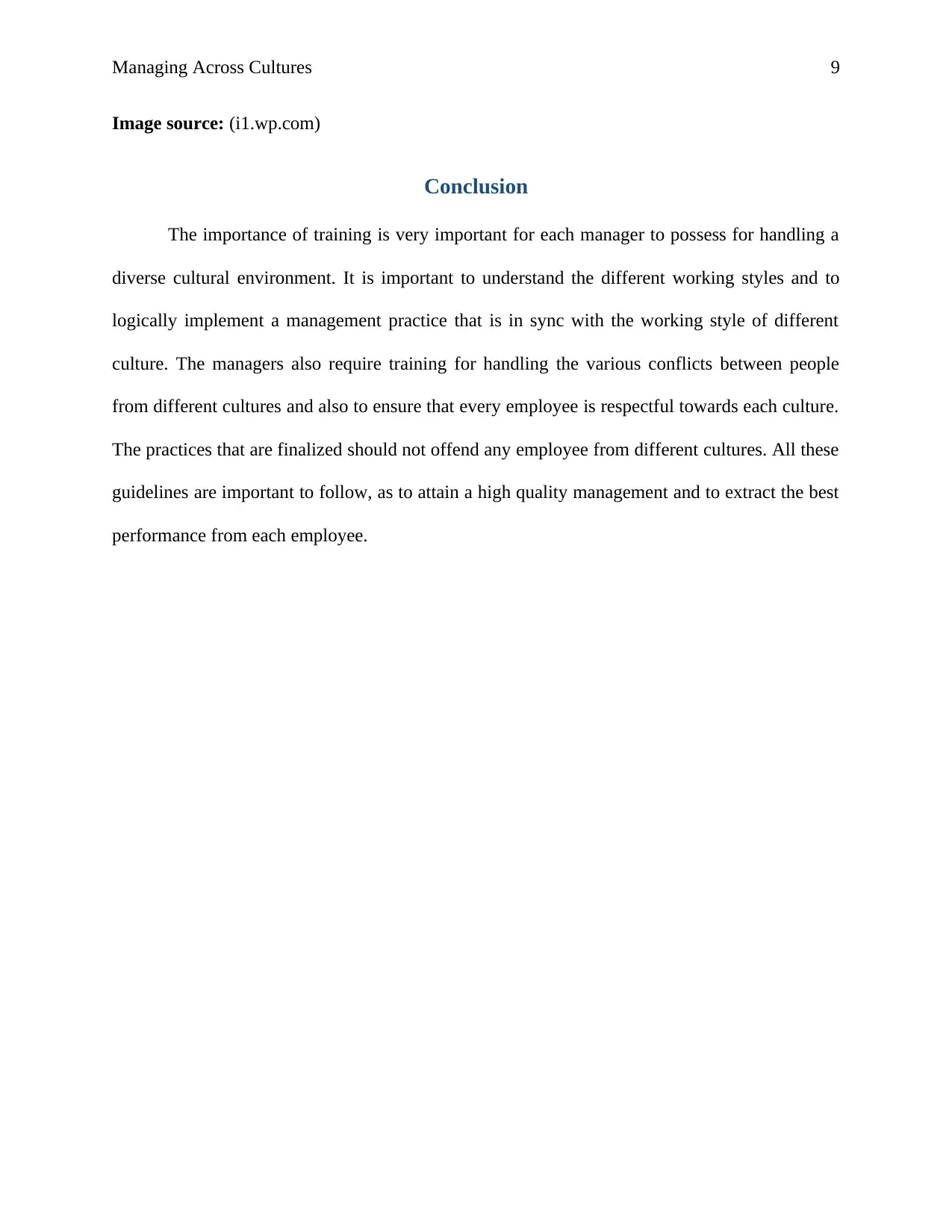
Managing Across Cultures 9
Image source: (i1.wp.com)
Conclusion
The importance of training is very important for each manager to possess for handling a
diverse cultural environment. It is important to understand the different working styles and to
logically implement a management practice that is in sync with the working style of different
culture. The managers also require training for handling the various conflicts between people
from different cultures and also to ensure that every employee is respectful towards each culture.
The practices that are finalized should not offend any employee from different cultures. All these
guidelines are important to follow, as to attain a high quality management and to extract the best
performance from each employee.
Image source: (i1.wp.com)
Conclusion
The importance of training is very important for each manager to possess for handling a
diverse cultural environment. It is important to understand the different working styles and to
logically implement a management practice that is in sync with the working style of different
culture. The managers also require training for handling the various conflicts between people
from different cultures and also to ensure that every employee is respectful towards each culture.
The practices that are finalized should not offend any employee from different cultures. All these
guidelines are important to follow, as to attain a high quality management and to extract the best
performance from each employee.
Secure Best Marks with AI Grader
Need help grading? Try our AI Grader for instant feedback on your assignments.
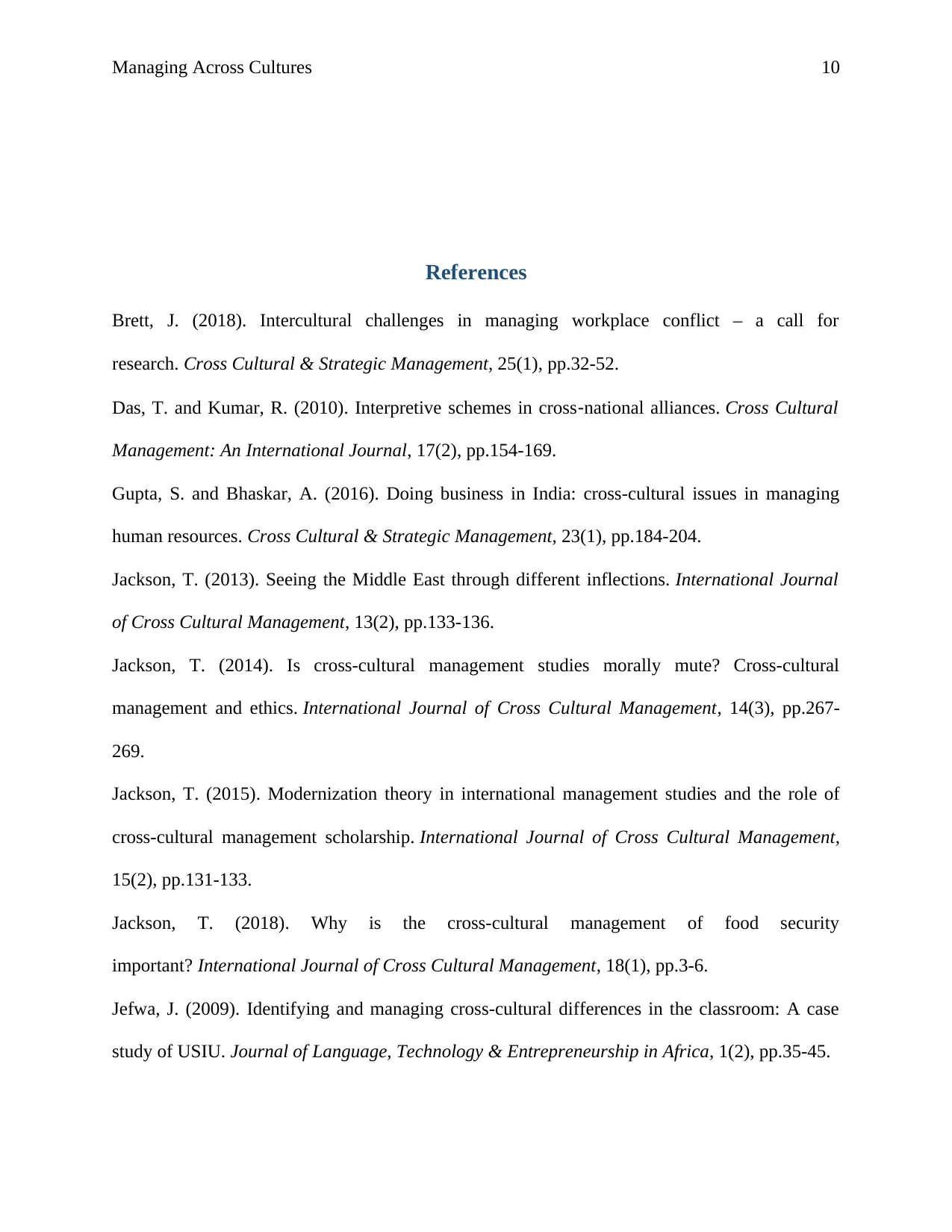
Managing Across Cultures 10
References
Brett, J. (2018). Intercultural challenges in managing workplace conflict – a call for
research. Cross Cultural & Strategic Management, 25(1), pp.32-52.
Das, T. and Kumar, R. (2010). Interpretive schemes in cross‐national alliances. Cross Cultural
Management: An International Journal, 17(2), pp.154-169.
Gupta, S. and Bhaskar, A. (2016). Doing business in India: cross-cultural issues in managing
human resources. Cross Cultural & Strategic Management, 23(1), pp.184-204.
Jackson, T. (2013). Seeing the Middle East through different inflections. International Journal
of Cross Cultural Management, 13(2), pp.133-136.
Jackson, T. (2014). Is cross-cultural management studies morally mute? Cross-cultural
management and ethics. International Journal of Cross Cultural Management, 14(3), pp.267-
269.
Jackson, T. (2015). Modernization theory in international management studies and the role of
cross-cultural management scholarship. International Journal of Cross Cultural Management,
15(2), pp.131-133.
Jackson, T. (2018). Why is the cross-cultural management of food security
important? International Journal of Cross Cultural Management, 18(1), pp.3-6.
Jefwa, J. (2009). Identifying and managing cross-cultural differences in the classroom: A case
study of USIU. Journal of Language, Technology & Entrepreneurship in Africa, 1(2), pp.35-45.
References
Brett, J. (2018). Intercultural challenges in managing workplace conflict – a call for
research. Cross Cultural & Strategic Management, 25(1), pp.32-52.
Das, T. and Kumar, R. (2010). Interpretive schemes in cross‐national alliances. Cross Cultural
Management: An International Journal, 17(2), pp.154-169.
Gupta, S. and Bhaskar, A. (2016). Doing business in India: cross-cultural issues in managing
human resources. Cross Cultural & Strategic Management, 23(1), pp.184-204.
Jackson, T. (2013). Seeing the Middle East through different inflections. International Journal
of Cross Cultural Management, 13(2), pp.133-136.
Jackson, T. (2014). Is cross-cultural management studies morally mute? Cross-cultural
management and ethics. International Journal of Cross Cultural Management, 14(3), pp.267-
269.
Jackson, T. (2015). Modernization theory in international management studies and the role of
cross-cultural management scholarship. International Journal of Cross Cultural Management,
15(2), pp.131-133.
Jackson, T. (2018). Why is the cross-cultural management of food security
important? International Journal of Cross Cultural Management, 18(1), pp.3-6.
Jefwa, J. (2009). Identifying and managing cross-cultural differences in the classroom: A case
study of USIU. Journal of Language, Technology & Entrepreneurship in Africa, 1(2), pp.35-45.
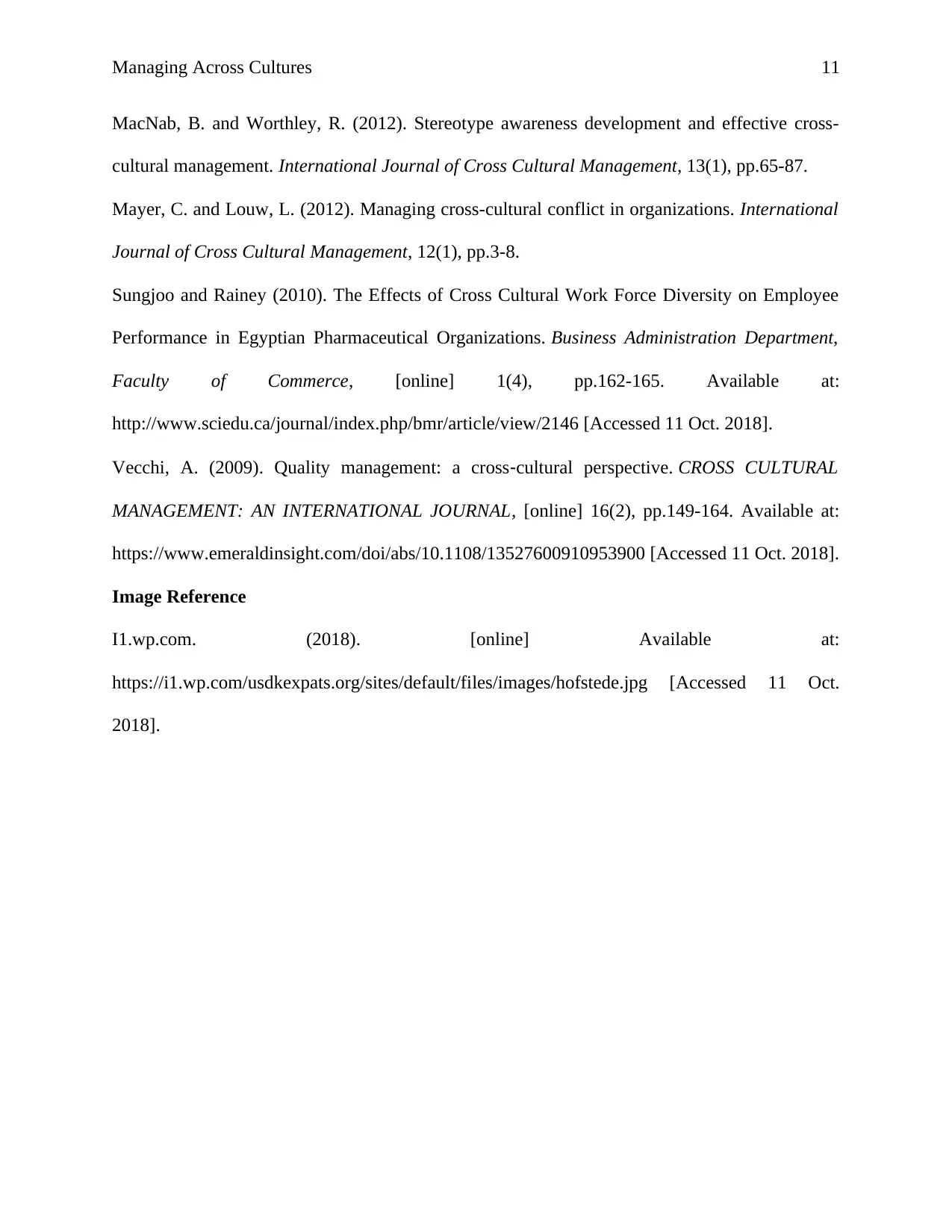
Managing Across Cultures 11
MacNab, B. and Worthley, R. (2012). Stereotype awareness development and effective cross-
cultural management. International Journal of Cross Cultural Management, 13(1), pp.65-87.
Mayer, C. and Louw, L. (2012). Managing cross-cultural conflict in organizations. International
Journal of Cross Cultural Management, 12(1), pp.3-8.
Sungjoo and Rainey (2010). The Effects of Cross Cultural Work Force Diversity on Employee
Performance in Egyptian Pharmaceutical Organizations. Business Administration Department,
Faculty of Commerce, [online] 1(4), pp.162-165. Available at:
http://www.sciedu.ca/journal/index.php/bmr/article/view/2146 [Accessed 11 Oct. 2018].
Vecchi, A. (2009). Quality management: a cross‐cultural perspective. CROSS CULTURAL
MANAGEMENT: AN INTERNATIONAL JOURNAL, [online] 16(2), pp.149-164. Available at:
https://www.emeraldinsight.com/doi/abs/10.1108/13527600910953900 [Accessed 11 Oct. 2018].
Image Reference
I1.wp.com. (2018). [online] Available at:
https://i1.wp.com/usdkexpats.org/sites/default/files/images/hofstede.jpg [Accessed 11 Oct.
2018].
MacNab, B. and Worthley, R. (2012). Stereotype awareness development and effective cross-
cultural management. International Journal of Cross Cultural Management, 13(1), pp.65-87.
Mayer, C. and Louw, L. (2012). Managing cross-cultural conflict in organizations. International
Journal of Cross Cultural Management, 12(1), pp.3-8.
Sungjoo and Rainey (2010). The Effects of Cross Cultural Work Force Diversity on Employee
Performance in Egyptian Pharmaceutical Organizations. Business Administration Department,
Faculty of Commerce, [online] 1(4), pp.162-165. Available at:
http://www.sciedu.ca/journal/index.php/bmr/article/view/2146 [Accessed 11 Oct. 2018].
Vecchi, A. (2009). Quality management: a cross‐cultural perspective. CROSS CULTURAL
MANAGEMENT: AN INTERNATIONAL JOURNAL, [online] 16(2), pp.149-164. Available at:
https://www.emeraldinsight.com/doi/abs/10.1108/13527600910953900 [Accessed 11 Oct. 2018].
Image Reference
I1.wp.com. (2018). [online] Available at:
https://i1.wp.com/usdkexpats.org/sites/default/files/images/hofstede.jpg [Accessed 11 Oct.
2018].
1 out of 12
Related Documents
Your All-in-One AI-Powered Toolkit for Academic Success.
+13062052269
info@desklib.com
Available 24*7 on WhatsApp / Email
![[object Object]](/_next/static/media/star-bottom.7253800d.svg)
Unlock your academic potential
© 2024 | Zucol Services PVT LTD | All rights reserved.



